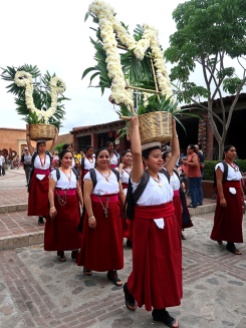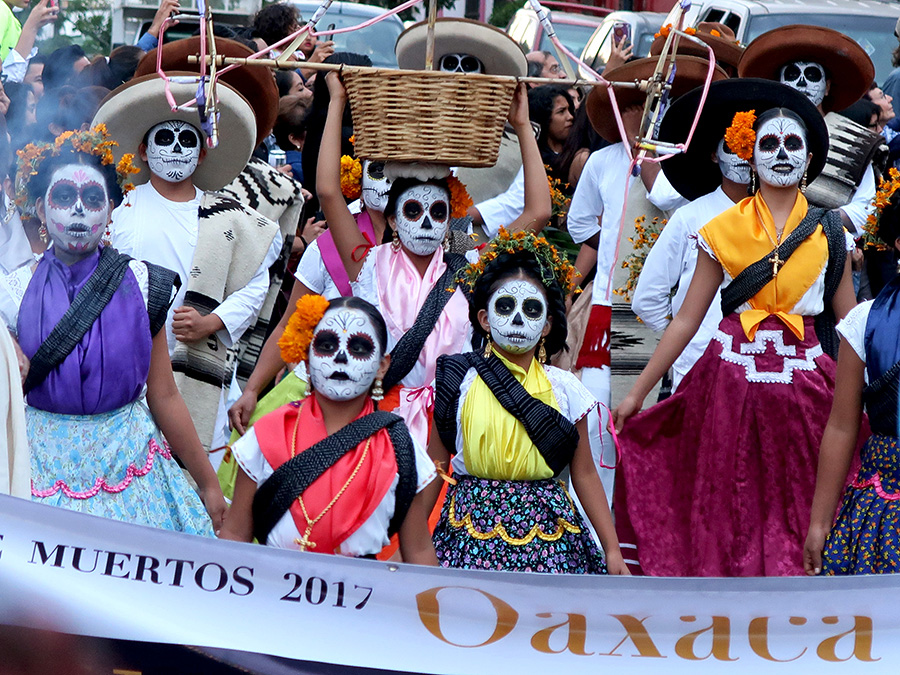Saturday saw the inauguration of the long awaited Centro Cultural Comunitario de Teotitlán del Valle (CCCTV). We, along with the citizens of this Zapotec community, have been wondering and watching the progress of the building, located between the municipal building and tapete (rug) vendor stalls, for 3+ years.

To begin the celebration, a desfile departed from the plaza in front of the new center, wound its way through the streets of Teotitlán, and returned to its starting point almost an hour later. Parading through town, there were kids and abuelas…
Community leaders and villagers…
And neighboring municipality, Tlacolula de Matamoros, participating with one of their gigantic marmotas and dancers.
There were two bands supplying a marching rhythm and soundtrack — the first to lead the procession and, at the tail, Los Reformistas, accompanying the Danza de la Pluma Promesa 2016-2018.
The danzantes danced their way onto the plaza and performed.
Then villagers and visitors settled down for words of welcome by community leaders and the new cultural center director Abigail Mendoza (yes, the world famous cocinera), food and drink prepared by the women of Teotitlán, and a moving song by Lila Downs, a madrina of the inauguration.

Lila Downs and Abigail Mendoza
By the way, several times during the event, Teotitecos proudly informed me that besides the CCCTV’s newly elected director, all the members of the cultural center’s governing committee are women.

Centro Cultural Comunitario director Abigail Mendoza (far left) and her committee.
There were musical performances and then a ribbon cutting to formally open the CCCTV — a building that was awarded the 2017 Cemex first place in the category of Collective Space, Gold Medal in the 3rd edition of the Architecture Biennial of Mexico City 2017, and the Silver Medal in the 15th edition of the National and International Biennial of Mexican Architecture 2018 (Centro Cultural de Teotitlán del Valle, Oaxaca).

Attempting to photograph the ribbon cutting

Mission statement of the CCCTV
At long last, the Centro Cultural Comunitario de Teotitlán del Valle was open to the public — and they poured in to view the spaces, exhibits, and Pablo Picasso community library.
However, that was far from the end of the celebration! A mini Guelaguetza began with the (above mentioned) delegation from Tlacolula, followed by the folkloric group, Grupo Dancistico Ritmo de Mi Raza, showcasing dances from the eight regions of the state of Oaxaca, and finished with an encore performance by Teotitlán’s Danza de la Pluma Promesa.

Dance from Huautla de Jiménez

Dance from the Mixe

Dance from Pinotepa Nacional

Jarabe del Valle, Chinas Oaxaqueñas
The celebration ended 10+ hours after it began, with the abuelas (seen above), village leaders, and the Cultural Center Committee dancing the jarabe in front of the municipal building, accompanied by the exploding sights and sounds of toritos dancing in the plaza, a few steps below.

In addition to permanent exhibits and library, the CCCTV also includes gardens, a store, meeting spaces, and will host temporary exhibitions, along with ongoing cultural and educational activities for children, youth, and adults.
Read Full Post »






























































































































































 Mexican Peso Converter
Mexican Peso Converter